Relationship Development in Alliance Contracting for Construction
VerifiedAdded on 2022/10/12
|18
|9252
|38
Report
AI Summary
This report analyzes a research paper titled "Alliance contracting: adding value through relationship development" published in Engineering, Construction and Architectural Management (ECAM). The study, conducted by Davis and Love, explores the significance of relationship development in successful alliance contracting within the Australian construction industry. The authors propose a three-phase model – assessment, commitment, and endurance – for building alliances. The research, based on 49 in-depth interviews with industry practitioners, highlights trust, commitment, and organizational development as critical factors. The paper emphasizes the need for a collaborative approach, moving away from traditional adversarial practices, to foster value creation and innovation throughout the supply chain. The model aims to promote reflective learning and mutual trust, ultimately improving project performance and sustainability in construction alliances. The research also addresses the challenges of maintaining relationships throughout a project's lifecycle, especially in the context of changing economic conditions and the increasing use of alliances as an alternative procurement method.
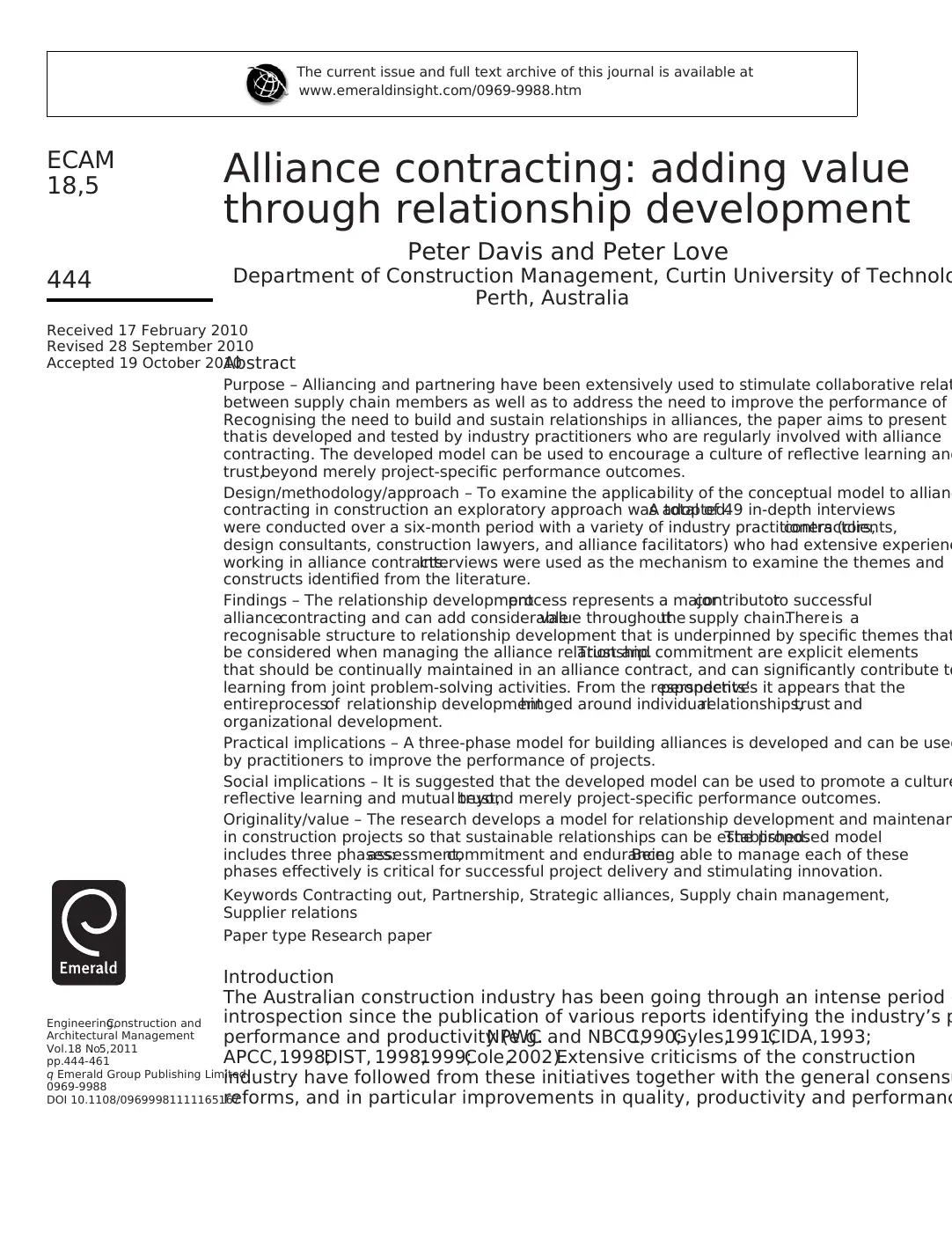
Alliance contracting: adding value
through relationship development
Peter Davis and Peter Love
Department of Construction Management, Curtin University of Technolo
Perth, Australia
Abstract
Purpose – Alliancing and partnering have been extensively used to stimulate collaborative relat
between supply chain members as well as to address the need to improve the performance of
Recognising the need to build and sustain relationships in alliances, the paper aims to present
thatis developed and tested by industry practitioners who are regularly involved with alliance
contracting. The developed model can be used to encourage a culture of reflective learning and
trust,beyond merely project-specific performance outcomes.
Design/methodology/approach – To examine the applicability of the conceptual model to allianc
contracting in construction an exploratory approach was adopted.A total of 49 in-depth interviews
were conducted over a six-month period with a variety of industry practitioners (clients,contractors,
design consultants, construction lawyers, and alliance facilitators) who had extensive experienc
working in alliance contracts.Interviews were used as the mechanism to examine the themes and
constructs identified from the literature.
Findings – The relationship developmentprocess represents a majorcontributorto successful
alliancecontracting and can add considerablevalue throughoutthe supply chain.Thereis a
recognisable structure to relationship development that is underpinned by specific themes that
be considered when managing the alliance relationship.Trust and commitment are explicit elements
that should be continually maintained in an alliance contract, and can significantly contribute to
learning from joint problem-solving activities. From the respondents’perspectives it appears that the
entireprocessof relationship developmenthinged around individualrelationships,trust and
organizational development.
Practical implications – A three-phase model for building alliances is developed and can be used
by practitioners to improve the performance of projects.
Social implications – It is suggested that the developed model can be used to promote a culture
reflective learning and mutual trust,beyond merely project-specific performance outcomes.
Originality/value – The research develops a model for relationship development and maintenan
in construction projects so that sustainable relationships can be established.The proposed model
includes three phases:assessment,commitment and endurance.Being able to manage each of these
phases effectively is critical for successful project delivery and stimulating innovation.
Keywords Contracting out, Partnership, Strategic alliances, Supply chain management,
Supplier relations
Paper type Research paper
Introduction
The Australian construction industry has been going through an intense period o
introspection since the publication of various reports identifying the industry’s p
performance and productivity (e.g.NPWC and NBCC,1990;Gyles,1991;CIDA,1993;
APCC,1998;DIST, 1998,1999;Cole,2002).Extensive criticisms of the construction
industry have followed from these initiatives together with the general consensu
reforms, and in particular improvements in quality, productivity and performanc
The current issue and full text archive of this journal is available at
www.emeraldinsight.com/0969-9988.htm
ECAM
18,5
444
Received 17 February 2010
Revised 28 September 2010
Accepted 19 October 2010
Engineering,Construction and
Architectural Management
Vol.18 No.5,2011
pp.444-461
q Emerald Group Publishing Limited
0969-9988
DOI 10.1108/09699981111165167
through relationship development
Peter Davis and Peter Love
Department of Construction Management, Curtin University of Technolo
Perth, Australia
Abstract
Purpose – Alliancing and partnering have been extensively used to stimulate collaborative relat
between supply chain members as well as to address the need to improve the performance of
Recognising the need to build and sustain relationships in alliances, the paper aims to present
thatis developed and tested by industry practitioners who are regularly involved with alliance
contracting. The developed model can be used to encourage a culture of reflective learning and
trust,beyond merely project-specific performance outcomes.
Design/methodology/approach – To examine the applicability of the conceptual model to allianc
contracting in construction an exploratory approach was adopted.A total of 49 in-depth interviews
were conducted over a six-month period with a variety of industry practitioners (clients,contractors,
design consultants, construction lawyers, and alliance facilitators) who had extensive experienc
working in alliance contracts.Interviews were used as the mechanism to examine the themes and
constructs identified from the literature.
Findings – The relationship developmentprocess represents a majorcontributorto successful
alliancecontracting and can add considerablevalue throughoutthe supply chain.Thereis a
recognisable structure to relationship development that is underpinned by specific themes that
be considered when managing the alliance relationship.Trust and commitment are explicit elements
that should be continually maintained in an alliance contract, and can significantly contribute to
learning from joint problem-solving activities. From the respondents’perspectives it appears that the
entireprocessof relationship developmenthinged around individualrelationships,trust and
organizational development.
Practical implications – A three-phase model for building alliances is developed and can be used
by practitioners to improve the performance of projects.
Social implications – It is suggested that the developed model can be used to promote a culture
reflective learning and mutual trust,beyond merely project-specific performance outcomes.
Originality/value – The research develops a model for relationship development and maintenan
in construction projects so that sustainable relationships can be established.The proposed model
includes three phases:assessment,commitment and endurance.Being able to manage each of these
phases effectively is critical for successful project delivery and stimulating innovation.
Keywords Contracting out, Partnership, Strategic alliances, Supply chain management,
Supplier relations
Paper type Research paper
Introduction
The Australian construction industry has been going through an intense period o
introspection since the publication of various reports identifying the industry’s p
performance and productivity (e.g.NPWC and NBCC,1990;Gyles,1991;CIDA,1993;
APCC,1998;DIST, 1998,1999;Cole,2002).Extensive criticisms of the construction
industry have followed from these initiatives together with the general consensu
reforms, and in particular improvements in quality, productivity and performanc
The current issue and full text archive of this journal is available at
www.emeraldinsight.com/0969-9988.htm
ECAM
18,5
444
Received 17 February 2010
Revised 28 September 2010
Accepted 19 October 2010
Engineering,Construction and
Architectural Management
Vol.18 No.5,2011
pp.444-461
q Emerald Group Publishing Limited
0969-9988
DOI 10.1108/09699981111165167
Paraphrase This Document
Need a fresh take? Get an instant paraphrase of this document with our AI Paraphraser
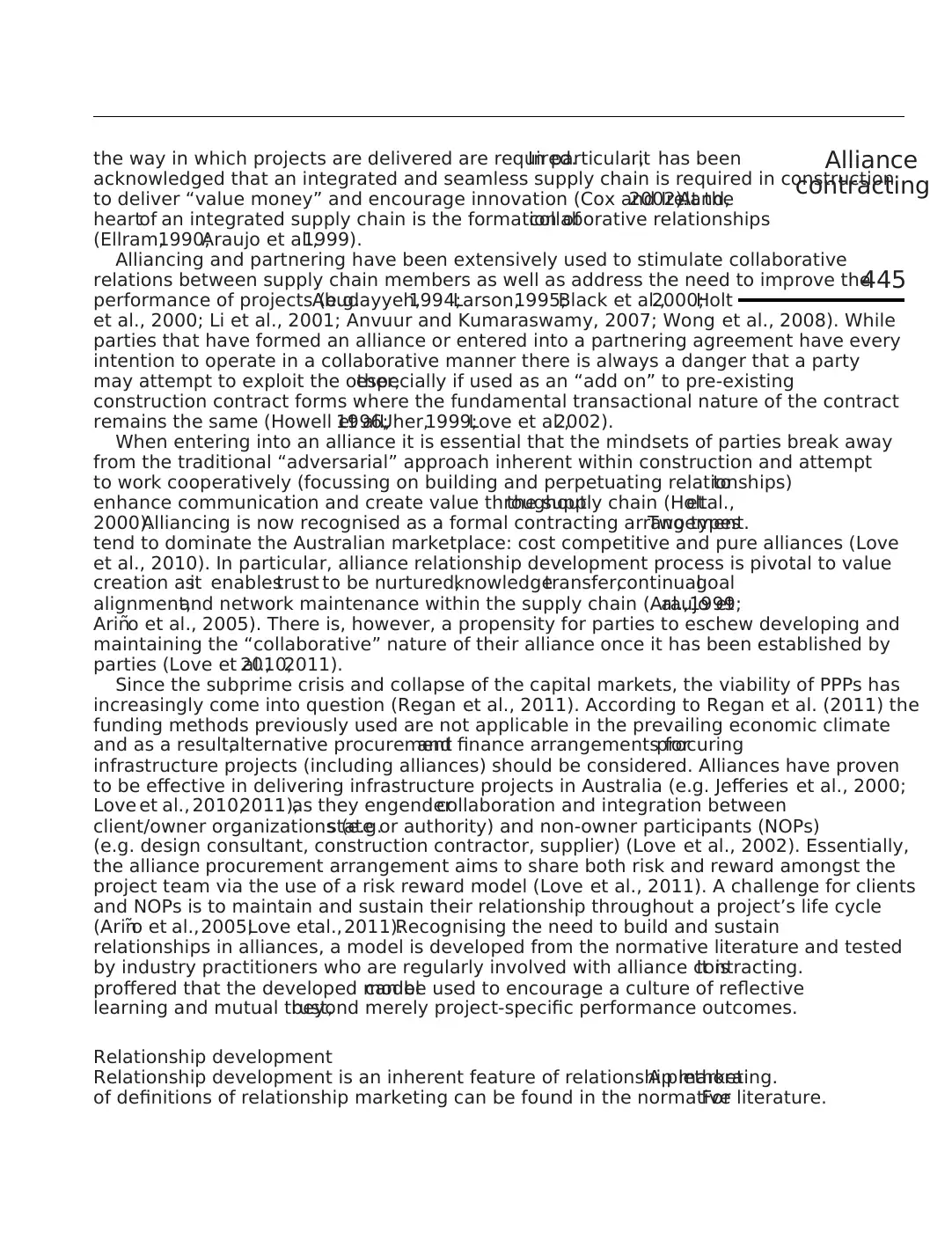
the way in which projects are delivered are required.In particular,it has been
acknowledged that an integrated and seamless supply chain is required in construction
to deliver “value money” and encourage innovation (Cox and Ireland,2002).At the
heartof an integrated supply chain is the formation ofcollaborative relationships
(Ellram,1990;Araujo et al.,1999).
Alliancing and partnering have been extensively used to stimulate collaborative
relations between supply chain members as well as address the need to improve the
performance of projects (e.g.Abudayyeh,1994;Larson,1995;Black et al.,2000;Holt
et al., 2000; Li et al., 2001; Anvuur and Kumaraswamy, 2007; Wong et al., 2008). While
parties that have formed an alliance or entered into a partnering agreement have every
intention to operate in a collaborative manner there is always a danger that a party
may attempt to exploit the other,especially if used as an “add on” to pre-existing
construction contract forms where the fundamental transactional nature of the contract
remains the same (Howell et al.,1996;Uher,1999;Love et al.,2002).
When entering into an alliance it is essential that the mindsets of parties break away
from the traditional “adversarial” approach inherent within construction and attempt
to work cooperatively (focussing on building and perpetuating relationships)to
enhance communication and create value throughoutthe supply chain (Holtet al.,
2000).Alliancing is now recognised as a formal contracting arrangement.Two types
tend to dominate the Australian marketplace: cost competitive and pure alliances (Love
et al., 2010). In particular, alliance relationship development process is pivotal to value
creation asit enablestrust to be nurtured,knowledgetransfer,continualgoal
alignment,and network maintenance within the supply chain (Araujo etal.,1999;
Arin˜o et al., 2005). There is, however, a propensity for parties to eschew developing and
maintaining the “collaborative” nature of their alliance once it has been established by
parties (Love et al.,2010,2011).
Since the subprime crisis and collapse of the capital markets, the viability of PPPs has
increasingly come into question (Regan et al., 2011). According to Regan et al. (2011) the
funding methods previously used are not applicable in the prevailing economic climate
and as a result,alternative procurementand finance arrangements forprocuring
infrastructure projects (including alliances) should be considered. Alliances have proven
to be effective in delivering infrastructure projects in Australia (e.g. Jefferies et al., 2000;
Love et al., 2010,2011),as they engendercollaboration and integration between
client/owner organizations (e.g.state or authority) and non-owner participants (NOPs)
(e.g. design consultant, construction contractor, supplier) (Love et al., 2002). Essentially,
the alliance procurement arrangement aims to share both risk and reward amongst the
project team via the use of a risk reward model (Love et al., 2011). A challenge for clients
and NOPs is to maintain and sustain their relationship throughout a project’s life cycle
(Arin˜o et al.,2005;Love etal.,2011).Recognising the need to build and sustain
relationships in alliances, a model is developed from the normative literature and tested
by industry practitioners who are regularly involved with alliance contracting.It is
proffered that the developed modelcan be used to encourage a culture of reflective
learning and mutual trust,beyond merely project-specific performance outcomes.
Relationship development
Relationship development is an inherent feature of relationship marketing.A plethora
of definitions of relationship marketing can be found in the normative literature.For
Alliance
contracting
445
acknowledged that an integrated and seamless supply chain is required in construction
to deliver “value money” and encourage innovation (Cox and Ireland,2002).At the
heartof an integrated supply chain is the formation ofcollaborative relationships
(Ellram,1990;Araujo et al.,1999).
Alliancing and partnering have been extensively used to stimulate collaborative
relations between supply chain members as well as address the need to improve the
performance of projects (e.g.Abudayyeh,1994;Larson,1995;Black et al.,2000;Holt
et al., 2000; Li et al., 2001; Anvuur and Kumaraswamy, 2007; Wong et al., 2008). While
parties that have formed an alliance or entered into a partnering agreement have every
intention to operate in a collaborative manner there is always a danger that a party
may attempt to exploit the other,especially if used as an “add on” to pre-existing
construction contract forms where the fundamental transactional nature of the contract
remains the same (Howell et al.,1996;Uher,1999;Love et al.,2002).
When entering into an alliance it is essential that the mindsets of parties break away
from the traditional “adversarial” approach inherent within construction and attempt
to work cooperatively (focussing on building and perpetuating relationships)to
enhance communication and create value throughoutthe supply chain (Holtet al.,
2000).Alliancing is now recognised as a formal contracting arrangement.Two types
tend to dominate the Australian marketplace: cost competitive and pure alliances (Love
et al., 2010). In particular, alliance relationship development process is pivotal to value
creation asit enablestrust to be nurtured,knowledgetransfer,continualgoal
alignment,and network maintenance within the supply chain (Araujo etal.,1999;
Arin˜o et al., 2005). There is, however, a propensity for parties to eschew developing and
maintaining the “collaborative” nature of their alliance once it has been established by
parties (Love et al.,2010,2011).
Since the subprime crisis and collapse of the capital markets, the viability of PPPs has
increasingly come into question (Regan et al., 2011). According to Regan et al. (2011) the
funding methods previously used are not applicable in the prevailing economic climate
and as a result,alternative procurementand finance arrangements forprocuring
infrastructure projects (including alliances) should be considered. Alliances have proven
to be effective in delivering infrastructure projects in Australia (e.g. Jefferies et al., 2000;
Love et al., 2010,2011),as they engendercollaboration and integration between
client/owner organizations (e.g.state or authority) and non-owner participants (NOPs)
(e.g. design consultant, construction contractor, supplier) (Love et al., 2002). Essentially,
the alliance procurement arrangement aims to share both risk and reward amongst the
project team via the use of a risk reward model (Love et al., 2011). A challenge for clients
and NOPs is to maintain and sustain their relationship throughout a project’s life cycle
(Arin˜o et al.,2005;Love etal.,2011).Recognising the need to build and sustain
relationships in alliances, a model is developed from the normative literature and tested
by industry practitioners who are regularly involved with alliance contracting.It is
proffered that the developed modelcan be used to encourage a culture of reflective
learning and mutual trust,beyond merely project-specific performance outcomes.
Relationship development
Relationship development is an inherent feature of relationship marketing.A plethora
of definitions of relationship marketing can be found in the normative literature.For
Alliance
contracting
445
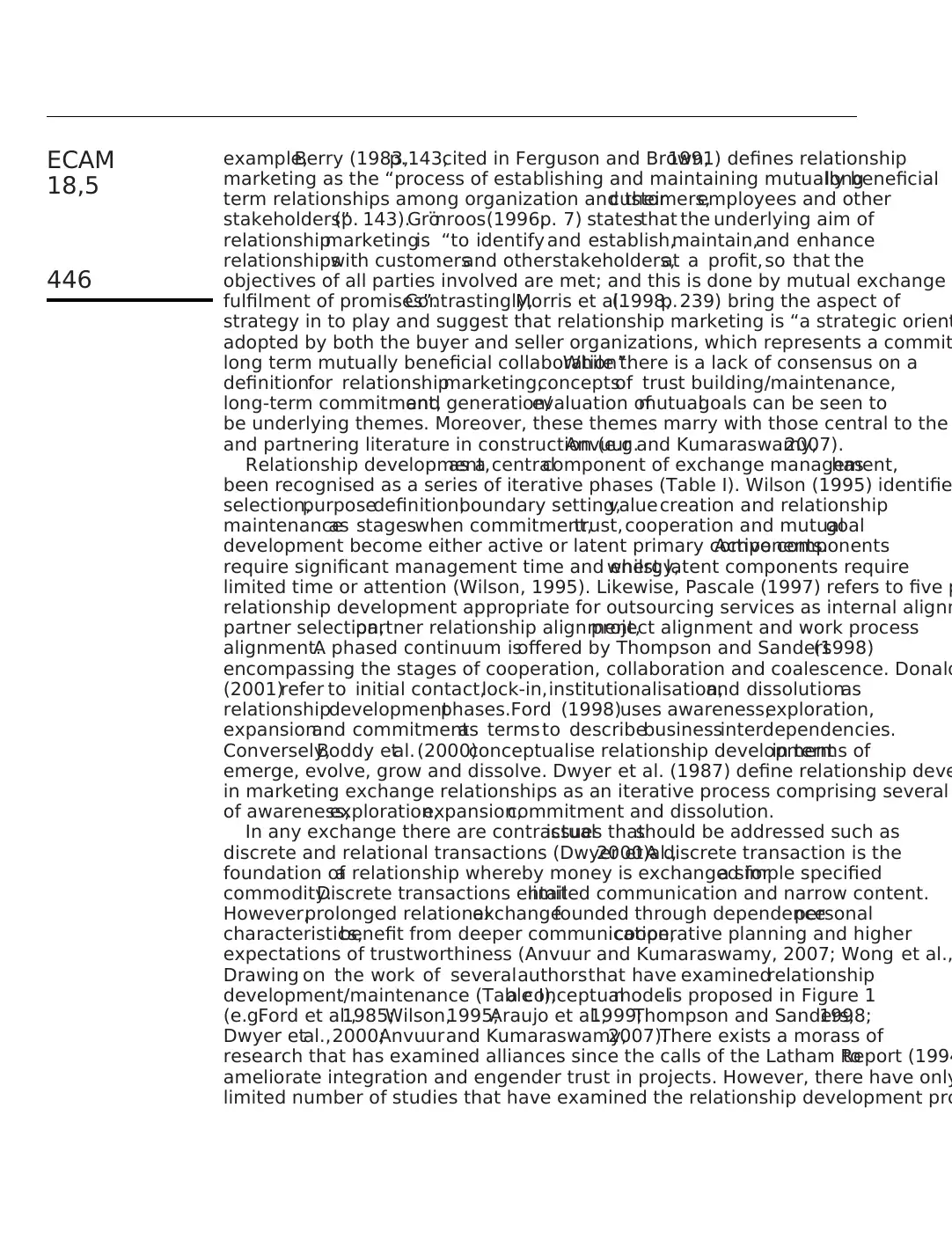
example,Berry (1983,p.143,cited in Ferguson and Brown,1991) defines relationship
marketing as the “process of establishing and maintaining mutually beneficiallong
term relationships among organization and theircustomers,employees and other
stakeholders”(p. 143).Gro¨nroos(1996,p. 7) statesthat the underlying aim of
relationshipmarketingis “to identify and establish,maintain,and enhance
relationshipswith customersand otherstakeholders,at a profit, so that the
objectives of all parties involved are met; and this is done by mutual exchange
fulfilment of promises”.Contrastingly,Morris et al.(1998,p.239) bring the aspect of
strategy in to play and suggest that relationship marketing is “a strategic orient
adopted by both the buyer and seller organizations, which represents a commit
long term mutually beneficial collaboration”.While there is a lack of consensus on a
definitionfor relationshipmarketing,conceptsof trust building/maintenance,
long-term commitment,and generation/evaluation ofmutualgoals can be seen to
be underlying themes. Moreover, these themes marry with those central to the
and partnering literature in construction (e.g.Anvuur and Kumaraswamy,2007).
Relationship development,as a centralcomponent of exchange management,has
been recognised as a series of iterative phases (Table I). Wilson (1995) identifie
selection,purposedefinition,boundary setting,valuecreation and relationship
maintenanceas stageswhen commitment,trust, cooperation and mutualgoal
development become either active or latent primary components.Active components
require significant management time and energy,whilst latent components require
limited time or attention (Wilson, 1995). Likewise, Pascale (1997) refers to five p
relationship development appropriate for outsourcing services as internal alignm
partner selection,partner relationship alignment,project alignment and work process
alignment.A phased continuum isoffered by Thompson and Sanders(1998)
encompassing the stages of cooperation, collaboration and coalescence. Donald
(2001)refer to initial contact,lock-in,institutionalisation,and dissolutionas
relationshipdevelopmentphases.Ford (1998)uses awareness,exploration,
expansionand commitmentas terms to describebusinessinterdependencies.
Conversely,Boddy etal. (2000)conceptualise relationship developmentin terms of
emerge, evolve, grow and dissolve. Dwyer et al. (1987) define relationship deve
in marketing exchange relationships as an iterative process comprising several
of awareness,exploration,expansion,commitment and dissolution.
In any exchange there are contractualissues thatshould be addressed such as
discrete and relational transactions (Dwyer et al.,2000).A discrete transaction is the
foundation ofa relationship whereby money is exchanged fora simple specified
commodity.Discrete transactions entaillimited communication and narrow content.
However,prolonged relationalexchangefounded through dependencepersonal
characteristics,benefit from deeper communication,cooperative planning and higher
expectations of trustworthiness (Anvuur and Kumaraswamy, 2007; Wong et al.,
Drawing on the work of severalauthorsthat have examinedrelationship
development/maintenance (Table I),a conceptualmodelis proposed in Figure 1
(e.g.Ford et al.,1985;Wilson,1995;Araujo et al.,1999;Thompson and Sanders,1998;
Dwyer etal.,2000;Anvuurand Kumaraswamy,2007).There exists a morass of
research that has examined alliances since the calls of the Latham Report (1994to
ameliorate integration and engender trust in projects. However, there have only
limited number of studies that have examined the relationship development pro
ECAM
18,5
446
marketing as the “process of establishing and maintaining mutually beneficiallong
term relationships among organization and theircustomers,employees and other
stakeholders”(p. 143).Gro¨nroos(1996,p. 7) statesthat the underlying aim of
relationshipmarketingis “to identify and establish,maintain,and enhance
relationshipswith customersand otherstakeholders,at a profit, so that the
objectives of all parties involved are met; and this is done by mutual exchange
fulfilment of promises”.Contrastingly,Morris et al.(1998,p.239) bring the aspect of
strategy in to play and suggest that relationship marketing is “a strategic orient
adopted by both the buyer and seller organizations, which represents a commit
long term mutually beneficial collaboration”.While there is a lack of consensus on a
definitionfor relationshipmarketing,conceptsof trust building/maintenance,
long-term commitment,and generation/evaluation ofmutualgoals can be seen to
be underlying themes. Moreover, these themes marry with those central to the
and partnering literature in construction (e.g.Anvuur and Kumaraswamy,2007).
Relationship development,as a centralcomponent of exchange management,has
been recognised as a series of iterative phases (Table I). Wilson (1995) identifie
selection,purposedefinition,boundary setting,valuecreation and relationship
maintenanceas stageswhen commitment,trust, cooperation and mutualgoal
development become either active or latent primary components.Active components
require significant management time and energy,whilst latent components require
limited time or attention (Wilson, 1995). Likewise, Pascale (1997) refers to five p
relationship development appropriate for outsourcing services as internal alignm
partner selection,partner relationship alignment,project alignment and work process
alignment.A phased continuum isoffered by Thompson and Sanders(1998)
encompassing the stages of cooperation, collaboration and coalescence. Donald
(2001)refer to initial contact,lock-in,institutionalisation,and dissolutionas
relationshipdevelopmentphases.Ford (1998)uses awareness,exploration,
expansionand commitmentas terms to describebusinessinterdependencies.
Conversely,Boddy etal. (2000)conceptualise relationship developmentin terms of
emerge, evolve, grow and dissolve. Dwyer et al. (1987) define relationship deve
in marketing exchange relationships as an iterative process comprising several
of awareness,exploration,expansion,commitment and dissolution.
In any exchange there are contractualissues thatshould be addressed such as
discrete and relational transactions (Dwyer et al.,2000).A discrete transaction is the
foundation ofa relationship whereby money is exchanged fora simple specified
commodity.Discrete transactions entaillimited communication and narrow content.
However,prolonged relationalexchangefounded through dependencepersonal
characteristics,benefit from deeper communication,cooperative planning and higher
expectations of trustworthiness (Anvuur and Kumaraswamy, 2007; Wong et al.,
Drawing on the work of severalauthorsthat have examinedrelationship
development/maintenance (Table I),a conceptualmodelis proposed in Figure 1
(e.g.Ford et al.,1985;Wilson,1995;Araujo et al.,1999;Thompson and Sanders,1998;
Dwyer etal.,2000;Anvuurand Kumaraswamy,2007).There exists a morass of
research that has examined alliances since the calls of the Latham Report (1994to
ameliorate integration and engender trust in projects. However, there have only
limited number of studies that have examined the relationship development pro
ECAM
18,5
446
⊘ This is a preview!⊘
Do you want full access?
Subscribe today to unlock all pages.

Trusted by 1+ million students worldwide
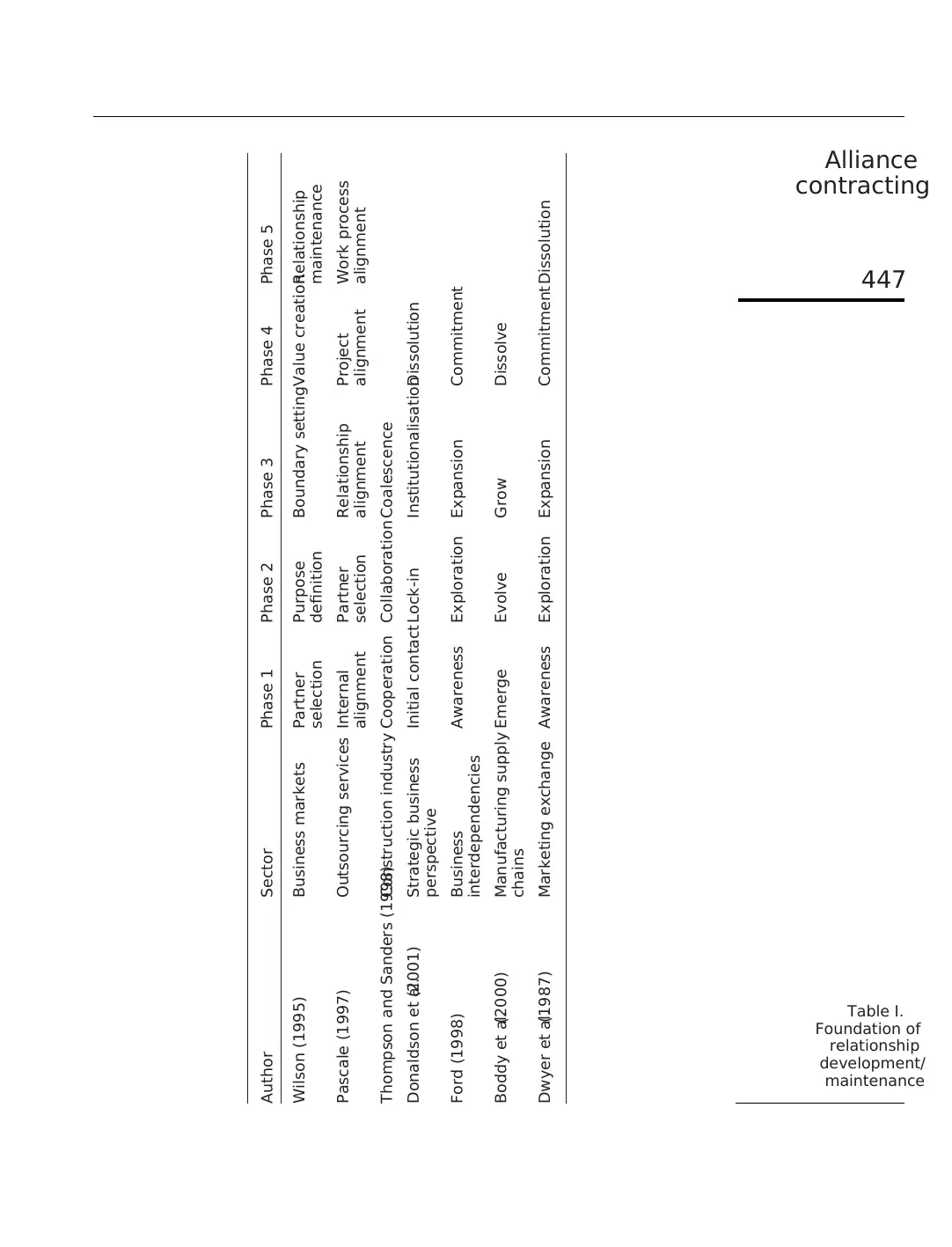
Author Sector Phase 1 Phase 2 Phase 3 Phase 4 Phase 5
Wilson (1995) Business markets Partner
selection
Purpose
definition
Boundary settingValue creationRelationship
maintenance
Pascale (1997) Outsourcing services Internal
alignment
Partner
selection
Relationship
alignment
Project
alignment
Work process
alignment
Thompson and Sanders (1998)Construction industry Cooperation Collaboration Coalescence
Donaldson et al.(2001) Strategic business
perspective
Initial contact Lock-in InstitutionalisationDissolution
Ford (1998) Business
interdependencies
Awareness Exploration Expansion Commitment
Boddy et al.(2000) Manufacturing supply
chains
Emerge Evolve Grow Dissolve
Dwyer et al.(1987) Marketing exchange Awareness Exploration Expansion CommitmentDissolution
Table I.
Foundation of
relationship
development/
maintenance
Alliance
contracting
447
Wilson (1995) Business markets Partner
selection
Purpose
definition
Boundary settingValue creationRelationship
maintenance
Pascale (1997) Outsourcing services Internal
alignment
Partner
selection
Relationship
alignment
Project
alignment
Work process
alignment
Thompson and Sanders (1998)Construction industry Cooperation Collaboration Coalescence
Donaldson et al.(2001) Strategic business
perspective
Initial contact Lock-in InstitutionalisationDissolution
Ford (1998) Business
interdependencies
Awareness Exploration Expansion Commitment
Boddy et al.(2000) Manufacturing supply
chains
Emerge Evolve Grow Dissolve
Dwyer et al.(1987) Marketing exchange Awareness Exploration Expansion CommitmentDissolution
Table I.
Foundation of
relationship
development/
maintenance
Alliance
contracting
447
Paraphrase This Document
Need a fresh take? Get an instant paraphrase of this document with our AI Paraphraser
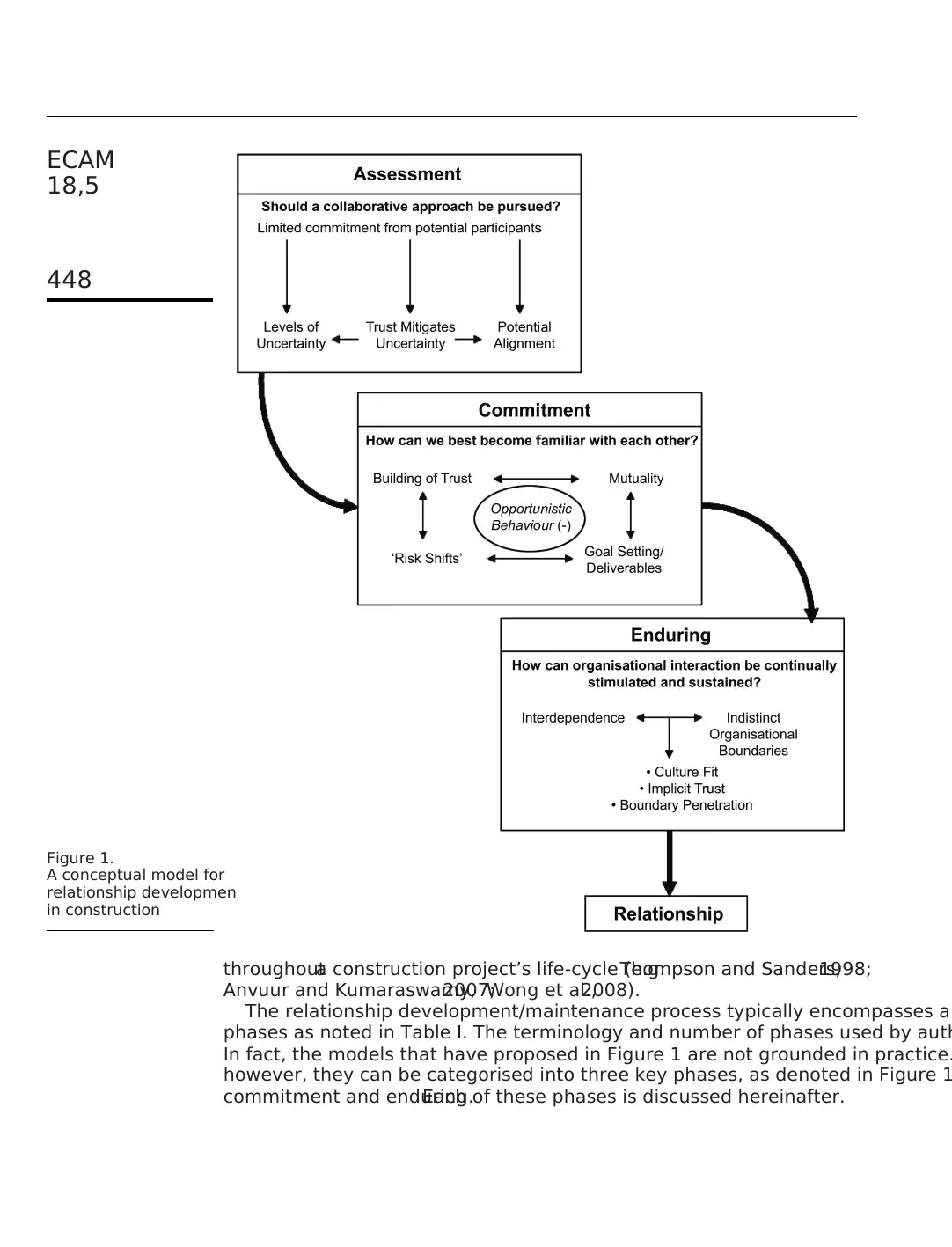
throughouta construction project’s life-cycle (e.g.Thompson and Sanders,1998;
Anvuur and Kumaraswamy,2007;Wong et al.,2008).
The relationship development/maintenance process typically encompasses a
phases as noted in Table I. The terminology and number of phases used by auth
In fact, the models that have proposed in Figure 1 are not grounded in practice.
however, they can be categorised into three key phases, as denoted in Figure 1
commitment and enduring.Each of these phases is discussed hereinafter.
Figure 1.
A conceptual model for
relationship development
in construction
ECAM
18,5
448
Anvuur and Kumaraswamy,2007;Wong et al.,2008).
The relationship development/maintenance process typically encompasses a
phases as noted in Table I. The terminology and number of phases used by auth
In fact, the models that have proposed in Figure 1 are not grounded in practice.
however, they can be categorised into three key phases, as denoted in Figure 1
commitment and enduring.Each of these phases is discussed hereinafter.
Figure 1.
A conceptual model for
relationship development
in construction
ECAM
18,5
448
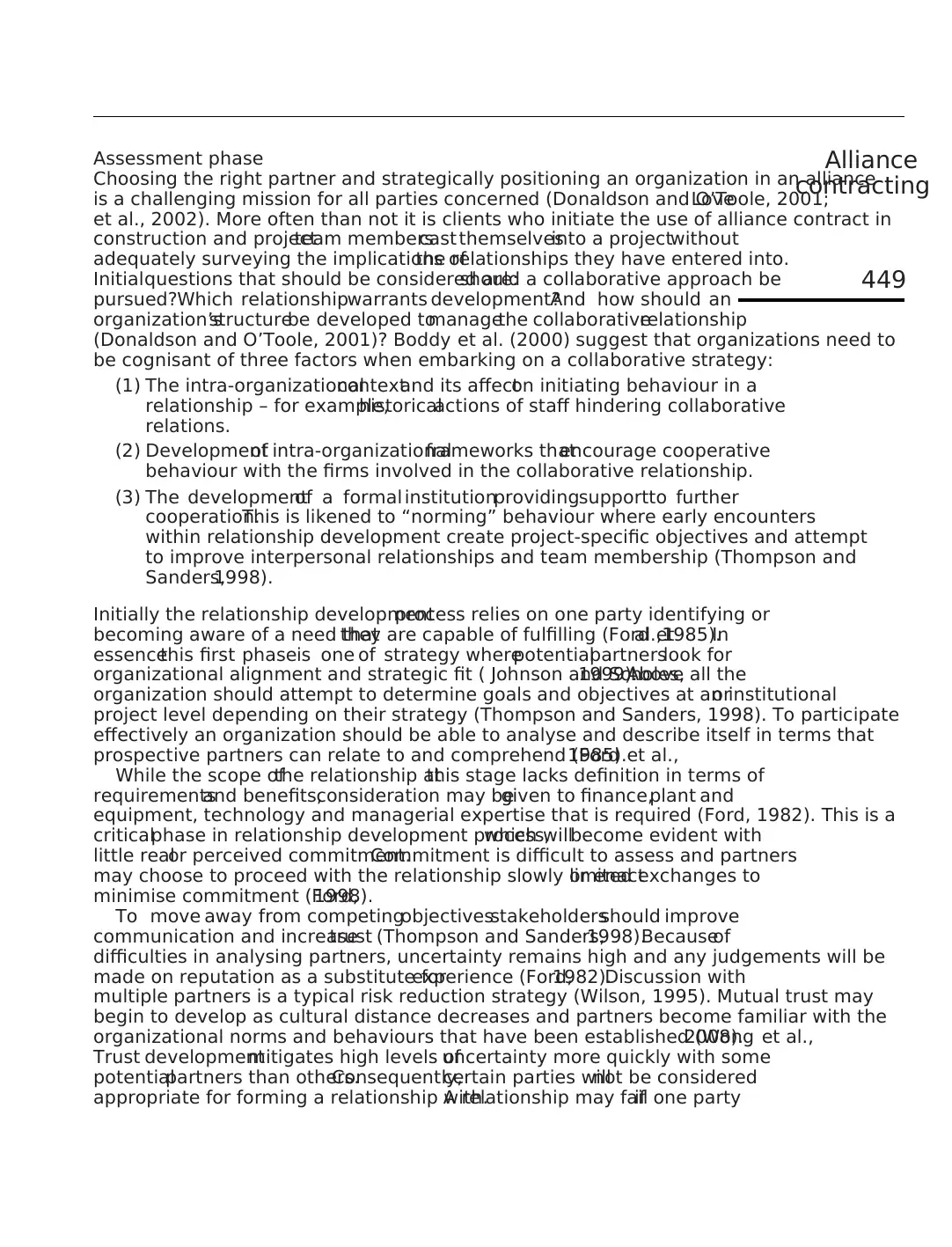
Assessment phase
Choosing the right partner and strategically positioning an organization in an alliance
is a challenging mission for all parties concerned (Donaldson and O’Toole, 2001;Love
et al., 2002). More often than not it is clients who initiate the use of alliance contract in
construction and projectteam memberscast themselvesinto a projectwithout
adequately surveying the implications ofthe relationships they have entered into.
Initialquestions that should be considered are:should a collaborative approach be
pursued?Which relationshipwarrants development?And how should an
organization’sstructurebe developed tomanagethe collaborativerelationship
(Donaldson and O’Toole, 2001)? Boddy et al. (2000) suggest that organizations need to
be cognisant of three factors when embarking on a collaborative strategy:
(1) The intra-organizationalcontextand its affecton initiating behaviour in a
relationship – for example,historicalactions of staff hindering collaborative
relations.
(2) Developmentof intra-organizationalframeworks thatencourage cooperative
behaviour with the firms involved in the collaborative relationship.
(3) The developmentof a formal institutionprovidingsupportto further
cooperation.This is likened to “norming” behaviour where early encounters
within relationship development create project-specific objectives and attempt
to improve interpersonal relationships and team membership (Thompson and
Sanders,1998).
Initially the relationship developmentprocess relies on one party identifying or
becoming aware of a need thatthey are capable of fulfilling (Ford etal.,1985).In
essencethis first phaseis one of strategy wherepotentialpartnerslook for
organizational alignment and strategic fit ( Johnson and Scholes,1999).Above all the
organization should attempt to determine goals and objectives at an institutionalor
project level depending on their strategy (Thompson and Sanders, 1998). To participate
effectively an organization should be able to analyse and describe itself in terms that
prospective partners can relate to and comprehend (Ford et al.,1985).
While the scope ofthe relationship atthis stage lacks definition in terms of
requirementsand benefits,consideration may begiven to finance,plant and
equipment, technology and managerial expertise that is required (Ford, 1982). This is a
criticalphase in relationship development process,which willbecome evident with
little realor perceived commitment.Commitment is difficult to assess and partners
may choose to proceed with the relationship slowly or enactlimited exchanges to
minimise commitment (Ford,1998).
To move away from competingobjectivesstakeholdersshould improve
communication and increasetrust (Thompson and Sanders,1998).Becauseof
difficulties in analysing partners, uncertainty remains high and any judgements will be
made on reputation as a substitute forexperience (Ford,1982).Discussion with
multiple partners is a typical risk reduction strategy (Wilson, 1995). Mutual trust may
begin to develop as cultural distance decreases and partners become familiar with the
organizational norms and behaviours that have been established (Wong et al.,2008).
Trust developmentmitigates high levels ofuncertainty more quickly with some
potentialpartners than others.Consequently,certain parties willnot be considered
appropriate for forming a relationship with.A relationship may failif one party
Alliance
contracting
449
Choosing the right partner and strategically positioning an organization in an alliance
is a challenging mission for all parties concerned (Donaldson and O’Toole, 2001;Love
et al., 2002). More often than not it is clients who initiate the use of alliance contract in
construction and projectteam memberscast themselvesinto a projectwithout
adequately surveying the implications ofthe relationships they have entered into.
Initialquestions that should be considered are:should a collaborative approach be
pursued?Which relationshipwarrants development?And how should an
organization’sstructurebe developed tomanagethe collaborativerelationship
(Donaldson and O’Toole, 2001)? Boddy et al. (2000) suggest that organizations need to
be cognisant of three factors when embarking on a collaborative strategy:
(1) The intra-organizationalcontextand its affecton initiating behaviour in a
relationship – for example,historicalactions of staff hindering collaborative
relations.
(2) Developmentof intra-organizationalframeworks thatencourage cooperative
behaviour with the firms involved in the collaborative relationship.
(3) The developmentof a formal institutionprovidingsupportto further
cooperation.This is likened to “norming” behaviour where early encounters
within relationship development create project-specific objectives and attempt
to improve interpersonal relationships and team membership (Thompson and
Sanders,1998).
Initially the relationship developmentprocess relies on one party identifying or
becoming aware of a need thatthey are capable of fulfilling (Ford etal.,1985).In
essencethis first phaseis one of strategy wherepotentialpartnerslook for
organizational alignment and strategic fit ( Johnson and Scholes,1999).Above all the
organization should attempt to determine goals and objectives at an institutionalor
project level depending on their strategy (Thompson and Sanders, 1998). To participate
effectively an organization should be able to analyse and describe itself in terms that
prospective partners can relate to and comprehend (Ford et al.,1985).
While the scope ofthe relationship atthis stage lacks definition in terms of
requirementsand benefits,consideration may begiven to finance,plant and
equipment, technology and managerial expertise that is required (Ford, 1982). This is a
criticalphase in relationship development process,which willbecome evident with
little realor perceived commitment.Commitment is difficult to assess and partners
may choose to proceed with the relationship slowly or enactlimited exchanges to
minimise commitment (Ford,1998).
To move away from competingobjectivesstakeholdersshould improve
communication and increasetrust (Thompson and Sanders,1998).Becauseof
difficulties in analysing partners, uncertainty remains high and any judgements will be
made on reputation as a substitute forexperience (Ford,1982).Discussion with
multiple partners is a typical risk reduction strategy (Wilson, 1995). Mutual trust may
begin to develop as cultural distance decreases and partners become familiar with the
organizational norms and behaviours that have been established (Wong et al.,2008).
Trust developmentmitigates high levels ofuncertainty more quickly with some
potentialpartners than others.Consequently,certain parties willnot be considered
appropriate for forming a relationship with.A relationship may failif one party
Alliance
contracting
449
⊘ This is a preview!⊘
Do you want full access?
Subscribe today to unlock all pages.

Trusted by 1+ million students worldwide
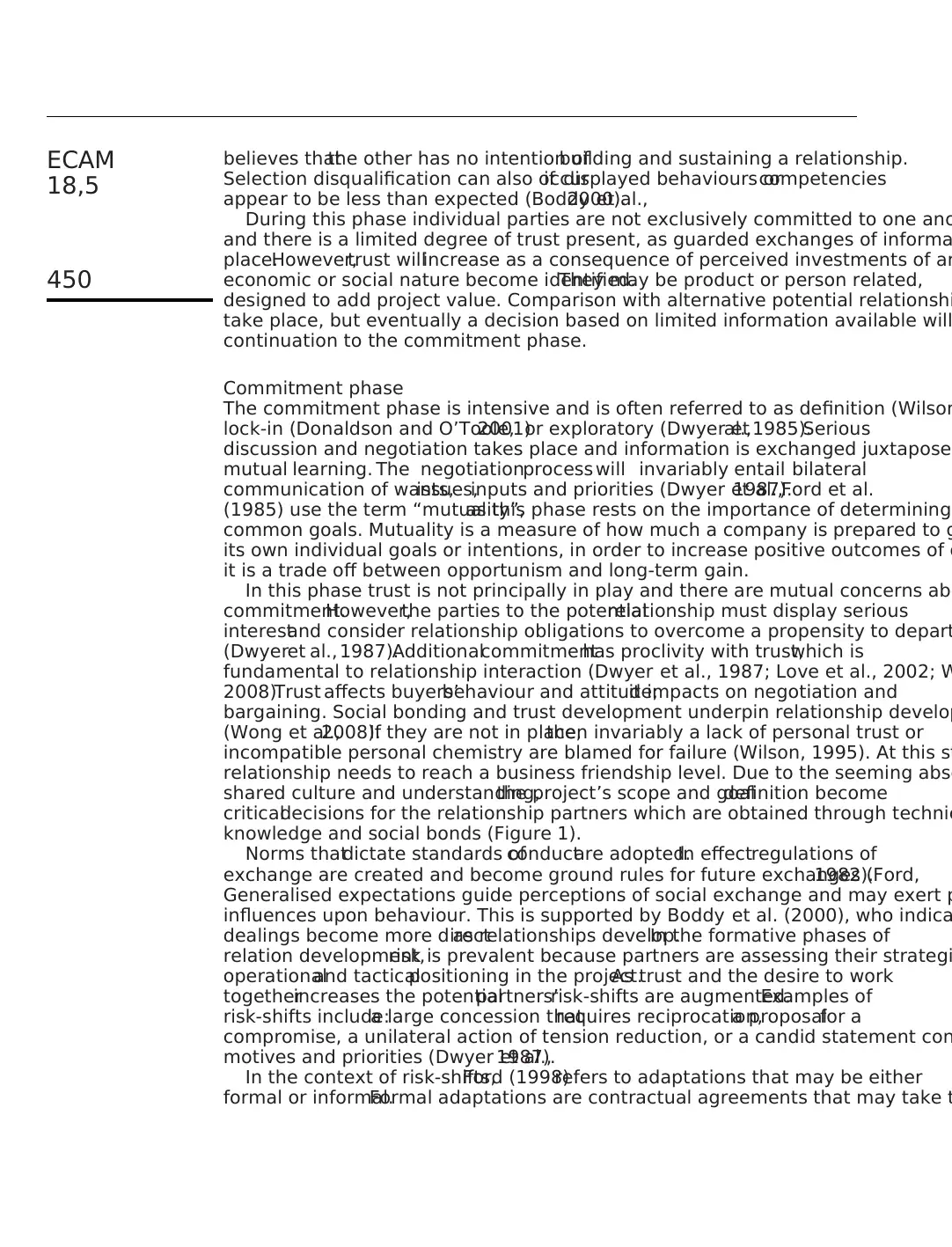
believes thatthe other has no intention ofbuilding and sustaining a relationship.
Selection disqualification can also occurif displayed behaviours orcompetencies
appear to be less than expected (Boddy et al.,2000).
During this phase individual parties are not exclusively committed to one ano
and there is a limited degree of trust present, as guarded exchanges of informa
place.However,trust willincrease as a consequence of perceived investments of an
economic or social nature become identified.They may be product or person related,
designed to add project value. Comparison with alternative potential relationshi
take place, but eventually a decision based on limited information available will
continuation to the commitment phase.
Commitment phase
The commitment phase is intensive and is often referred to as definition (Wilson
lock-in (Donaldson and O’Toole,2001)or exploratory (Dwyer etal.,1985).Serious
discussion and negotiation takes place and information is exchanged juxtapose
mutual learning. The negotiationprocess will invariably entail bilateral
communication of wants,issues,inputs and priorities (Dwyer et al.,1987).Ford et al.
(1985) use the term “mutuality”,as this phase rests on the importance of determining
common goals. Mutuality is a measure of how much a company is prepared to g
its own individual goals or intentions, in order to increase positive outcomes of o
it is a trade off between opportunism and long-term gain.
In this phase trust is not principally in play and there are mutual concerns abo
commitment.However,the parties to the potentialrelationship must display serious
interestand consider relationship obligations to overcome a propensity to depart
(Dwyeret al., 1987).Additionalcommitmenthas proclivity with trust,which is
fundamental to relationship interaction (Dwyer et al., 1987; Love et al., 2002; W
2008).Trust affects buyers’behaviour and attitude;it impacts on negotiation and
bargaining. Social bonding and trust development underpin relationship develop
(Wong et al.,2008).If they are not in place,then invariably a lack of personal trust or
incompatible personal chemistry are blamed for failure (Wilson, 1995). At this st
relationship needs to reach a business friendship level. Due to the seeming abse
shared culture and understanding,the project’s scope and goaldefinition become
criticaldecisions for the relationship partners which are obtained through technic
knowledge and social bonds (Figure 1).
Norms thatdictate standards ofconductare adopted.In effectregulations of
exchange are created and become ground rules for future exchanges (Ford,1982).
Generalised expectations guide perceptions of social exchange and may exert p
influences upon behaviour. This is supported by Boddy et al. (2000), who indica
dealings become more directas relationships develop.In the formative phases of
relation development,risk is prevalent because partners are assessing their strategi
operationaland tacticalpositioning in the project.As trust and the desire to work
togetherincreases the potentialpartners’risk-shifts are augmented.Examples of
risk-shifts include:a large concession thatrequires reciprocation,a proposalfor a
compromise, a unilateral action of tension reduction, or a candid statement con
motives and priorities (Dwyer et al.,1987).
In the context of risk-shifts,Ford (1998)refers to adaptations that may be either
formal or informal.Formal adaptations are contractual agreements that may take t
ECAM
18,5
450
Selection disqualification can also occurif displayed behaviours orcompetencies
appear to be less than expected (Boddy et al.,2000).
During this phase individual parties are not exclusively committed to one ano
and there is a limited degree of trust present, as guarded exchanges of informa
place.However,trust willincrease as a consequence of perceived investments of an
economic or social nature become identified.They may be product or person related,
designed to add project value. Comparison with alternative potential relationshi
take place, but eventually a decision based on limited information available will
continuation to the commitment phase.
Commitment phase
The commitment phase is intensive and is often referred to as definition (Wilson
lock-in (Donaldson and O’Toole,2001)or exploratory (Dwyer etal.,1985).Serious
discussion and negotiation takes place and information is exchanged juxtapose
mutual learning. The negotiationprocess will invariably entail bilateral
communication of wants,issues,inputs and priorities (Dwyer et al.,1987).Ford et al.
(1985) use the term “mutuality”,as this phase rests on the importance of determining
common goals. Mutuality is a measure of how much a company is prepared to g
its own individual goals or intentions, in order to increase positive outcomes of o
it is a trade off between opportunism and long-term gain.
In this phase trust is not principally in play and there are mutual concerns abo
commitment.However,the parties to the potentialrelationship must display serious
interestand consider relationship obligations to overcome a propensity to depart
(Dwyeret al., 1987).Additionalcommitmenthas proclivity with trust,which is
fundamental to relationship interaction (Dwyer et al., 1987; Love et al., 2002; W
2008).Trust affects buyers’behaviour and attitude;it impacts on negotiation and
bargaining. Social bonding and trust development underpin relationship develop
(Wong et al.,2008).If they are not in place,then invariably a lack of personal trust or
incompatible personal chemistry are blamed for failure (Wilson, 1995). At this st
relationship needs to reach a business friendship level. Due to the seeming abse
shared culture and understanding,the project’s scope and goaldefinition become
criticaldecisions for the relationship partners which are obtained through technic
knowledge and social bonds (Figure 1).
Norms thatdictate standards ofconductare adopted.In effectregulations of
exchange are created and become ground rules for future exchanges (Ford,1982).
Generalised expectations guide perceptions of social exchange and may exert p
influences upon behaviour. This is supported by Boddy et al. (2000), who indica
dealings become more directas relationships develop.In the formative phases of
relation development,risk is prevalent because partners are assessing their strategi
operationaland tacticalpositioning in the project.As trust and the desire to work
togetherincreases the potentialpartners’risk-shifts are augmented.Examples of
risk-shifts include:a large concession thatrequires reciprocation,a proposalfor a
compromise, a unilateral action of tension reduction, or a candid statement con
motives and priorities (Dwyer et al.,1987).
In the context of risk-shifts,Ford (1998)refers to adaptations that may be either
formal or informal.Formal adaptations are contractual agreements that may take t
ECAM
18,5
450
Paraphrase This Document
Need a fresh take? Get an instant paraphrase of this document with our AI Paraphraser
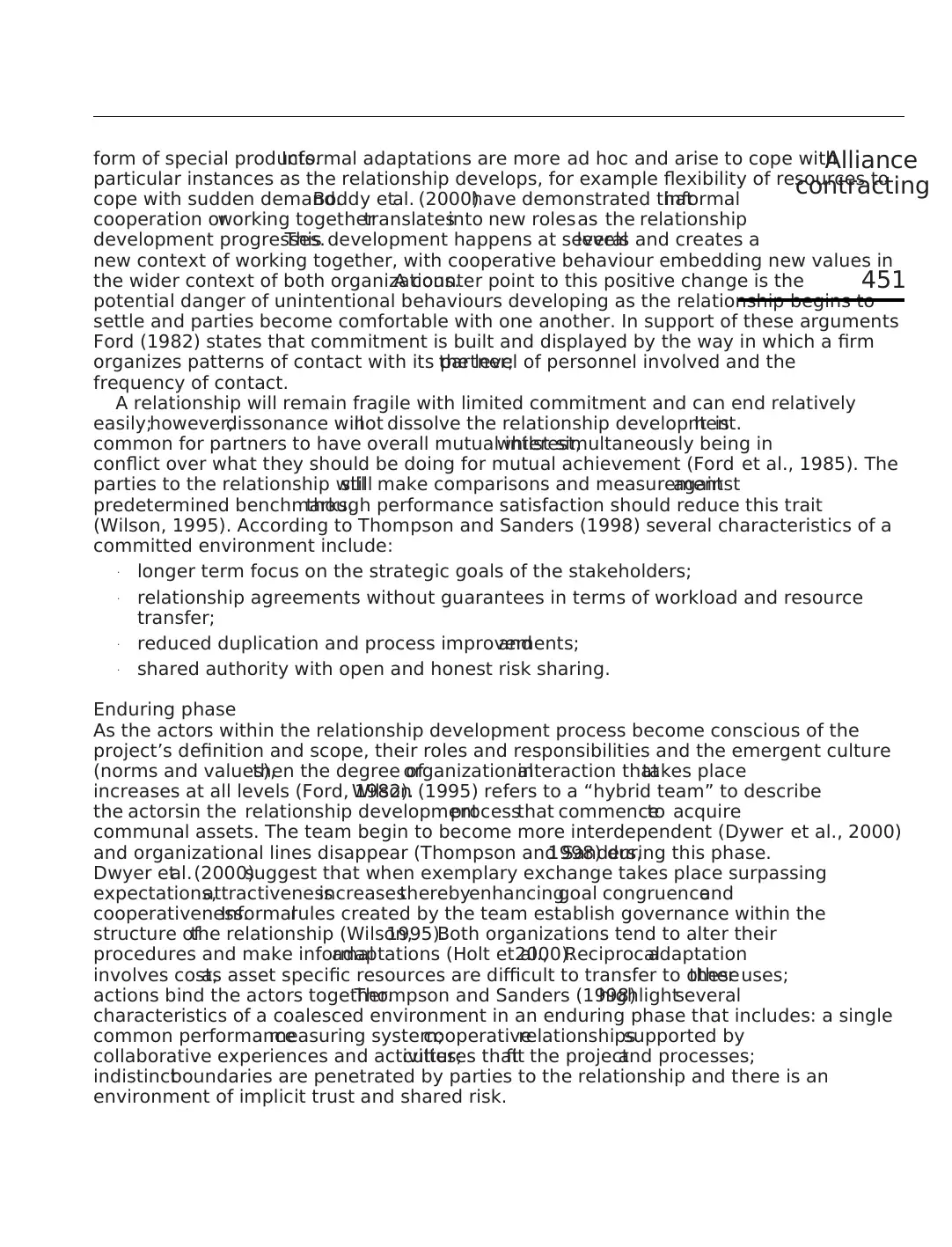
form of special products.Informal adaptations are more ad hoc and arise to cope with
particular instances as the relationship develops, for example flexibility of resources to
cope with sudden demand.Boddy etal. (2000)have demonstrated thatinformal
cooperation orworking togethertranslatesinto new rolesas the relationship
development progresses.This development happens at severallevels and creates a
new context of working together, with cooperative behaviour embedding new values in
the wider context of both organizations.A counter point to this positive change is the
potential danger of unintentional behaviours developing as the relationship begins to
settle and parties become comfortable with one another. In support of these arguments
Ford (1982) states that commitment is built and displayed by the way in which a firm
organizes patterns of contact with its partner;the level of personnel involved and the
frequency of contact.
A relationship will remain fragile with limited commitment and can end relatively
easily;however,dissonance willnot dissolve the relationship development.It is
common for partners to have overall mutual interest,whilst simultaneously being in
conflict over what they should be doing for mutual achievement (Ford et al., 1985). The
parties to the relationship willstill make comparisons and measurementagainst
predetermined benchmarks,though performance satisfaction should reduce this trait
(Wilson, 1995). According to Thompson and Sanders (1998) several characteristics of a
committed environment include:
. longer term focus on the strategic goals of the stakeholders;
. relationship agreements without guarantees in terms of workload and resource
transfer;
. reduced duplication and process improvements;and
. shared authority with open and honest risk sharing.
Enduring phase
As the actors within the relationship development process become conscious of the
project’s definition and scope, their roles and responsibilities and the emergent culture
(norms and values),then the degree oforganizationalinteraction thattakes place
increases at all levels (Ford, 1982).Wilson (1995) refers to a “hybrid team” to describe
the actorsin the relationship developmentprocessthat commenceto acquire
communal assets. The team begin to become more interdependent (Dywer et al., 2000)
and organizational lines disappear (Thompson and Sanders,1998) during this phase.
Dwyer etal.(2000)suggest that when exemplary exchange takes place surpassing
expectations,attractivenessincreasestherebyenhancinggoal congruenceand
cooperativeness.Informalrules created by the team establish governance within the
structure ofthe relationship (Wilson,1995).Both organizations tend to alter their
procedures and make informaladaptations (Holt et al.,2000).Reciprocaladaptation
involves cost,as asset specific resources are difficult to transfer to other uses;these
actions bind the actors together.Thompson and Sanders (1998)highlightseveral
characteristics of a coalesced environment in an enduring phase that includes: a single
common performancemeasuring system;cooperativerelationshipssupported by
collaborative experiences and activities;cultures thatfit the projectand processes;
indistinctboundaries are penetrated by parties to the relationship and there is an
environment of implicit trust and shared risk.
Alliance
contracting
451
particular instances as the relationship develops, for example flexibility of resources to
cope with sudden demand.Boddy etal. (2000)have demonstrated thatinformal
cooperation orworking togethertranslatesinto new rolesas the relationship
development progresses.This development happens at severallevels and creates a
new context of working together, with cooperative behaviour embedding new values in
the wider context of both organizations.A counter point to this positive change is the
potential danger of unintentional behaviours developing as the relationship begins to
settle and parties become comfortable with one another. In support of these arguments
Ford (1982) states that commitment is built and displayed by the way in which a firm
organizes patterns of contact with its partner;the level of personnel involved and the
frequency of contact.
A relationship will remain fragile with limited commitment and can end relatively
easily;however,dissonance willnot dissolve the relationship development.It is
common for partners to have overall mutual interest,whilst simultaneously being in
conflict over what they should be doing for mutual achievement (Ford et al., 1985). The
parties to the relationship willstill make comparisons and measurementagainst
predetermined benchmarks,though performance satisfaction should reduce this trait
(Wilson, 1995). According to Thompson and Sanders (1998) several characteristics of a
committed environment include:
. longer term focus on the strategic goals of the stakeholders;
. relationship agreements without guarantees in terms of workload and resource
transfer;
. reduced duplication and process improvements;and
. shared authority with open and honest risk sharing.
Enduring phase
As the actors within the relationship development process become conscious of the
project’s definition and scope, their roles and responsibilities and the emergent culture
(norms and values),then the degree oforganizationalinteraction thattakes place
increases at all levels (Ford, 1982).Wilson (1995) refers to a “hybrid team” to describe
the actorsin the relationship developmentprocessthat commenceto acquire
communal assets. The team begin to become more interdependent (Dywer et al., 2000)
and organizational lines disappear (Thompson and Sanders,1998) during this phase.
Dwyer etal.(2000)suggest that when exemplary exchange takes place surpassing
expectations,attractivenessincreasestherebyenhancinggoal congruenceand
cooperativeness.Informalrules created by the team establish governance within the
structure ofthe relationship (Wilson,1995).Both organizations tend to alter their
procedures and make informaladaptations (Holt et al.,2000).Reciprocaladaptation
involves cost,as asset specific resources are difficult to transfer to other uses;these
actions bind the actors together.Thompson and Sanders (1998)highlightseveral
characteristics of a coalesced environment in an enduring phase that includes: a single
common performancemeasuring system;cooperativerelationshipssupported by
collaborative experiences and activities;cultures thatfit the projectand processes;
indistinctboundaries are penetrated by parties to the relationship and there is an
environment of implicit trust and shared risk.
Alliance
contracting
451
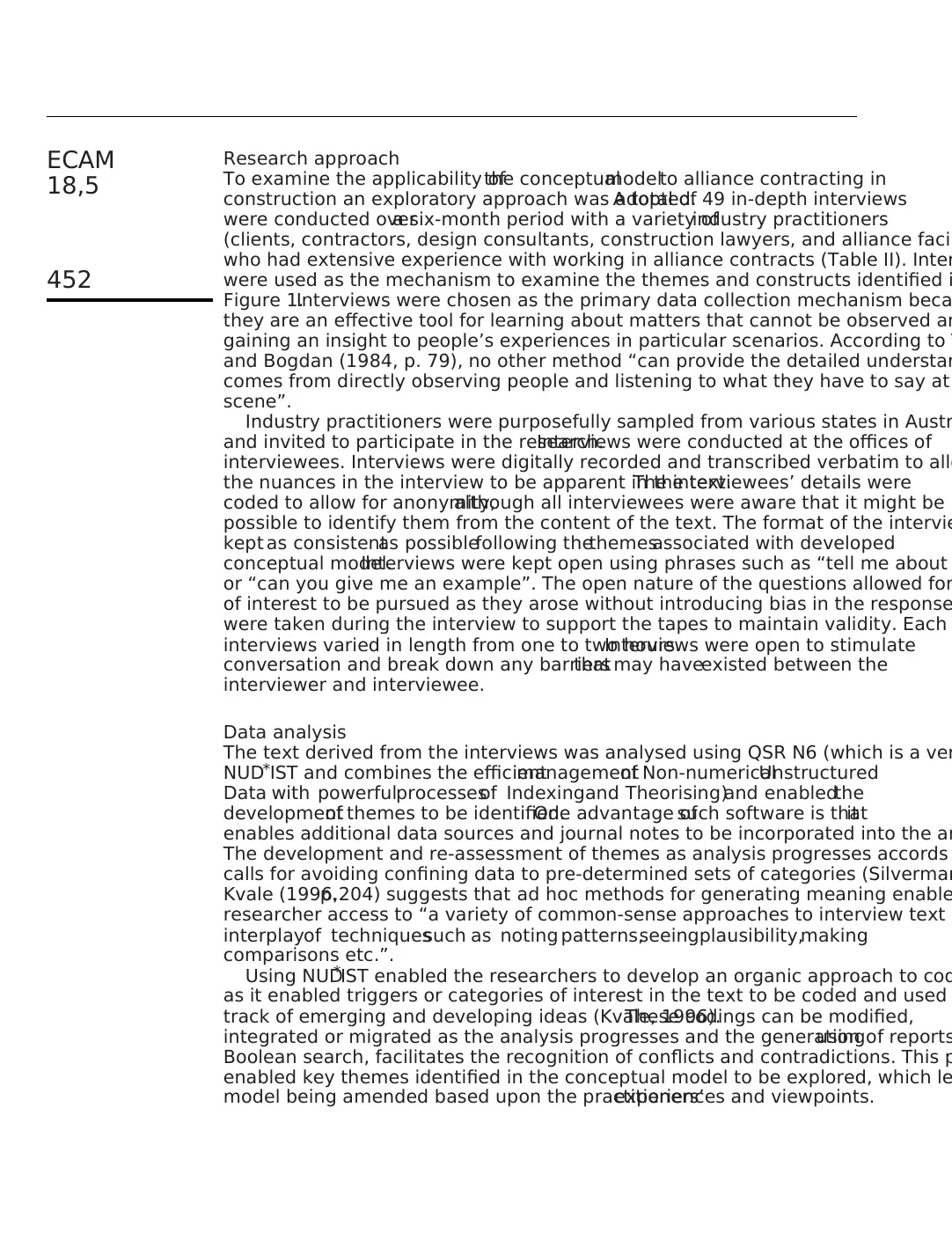
Research approach
To examine the applicability ofthe conceptualmodelto alliance contracting in
construction an exploratory approach was adopted.A total of 49 in-depth interviews
were conducted overa six-month period with a variety ofindustry practitioners
(clients, contractors, design consultants, construction lawyers, and alliance facil
who had extensive experience with working in alliance contracts (Table II). Inter
were used as the mechanism to examine the themes and constructs identified i
Figure 1.Interviews were chosen as the primary data collection mechanism beca
they are an effective tool for learning about matters that cannot be observed an
gaining an insight to people’s experiences in particular scenarios. According to T
and Bogdan (1984, p. 79), no other method “can provide the detailed understan
comes from directly observing people and listening to what they have to say at
scene”.
Industry practitioners were purposefully sampled from various states in Austr
and invited to participate in the research.Interviews were conducted at the offices of
interviewees. Interviews were digitally recorded and transcribed verbatim to allo
the nuances in the interview to be apparent in the text.The interviewees’ details were
coded to allow for anonymity,although all interviewees were aware that it might be
possible to identify them from the content of the text. The format of the intervie
kept as consistentas possiblefollowing thethemesassociated with developed
conceptual model.Interviews were kept open using phrases such as “tell me about
or “can you give me an example”. The open nature of the questions allowed for
of interest to be pursued as they arose without introducing bias in the response
were taken during the interview to support the tapes to maintain validity. Each
interviews varied in length from one to two hours.Interviews were open to stimulate
conversation and break down any barriersthat may haveexisted between the
interviewer and interviewee.
Data analysis
The text derived from the interviews was analysed using QSR N6 (which is a ver
NUD*IST and combines the efficientmanagementof Non-numericalUnstructured
Data with powerfulprocessesof Indexingand Theorising)and enabledthe
developmentof themes to be identified.One advantage ofsuch software is thatit
enables additional data sources and journal notes to be incorporated into the an
The development and re-assessment of themes as analysis progresses accords
calls for avoiding confining data to pre-determined sets of categories (Silverman
Kvale (1996,p.204) suggests that ad hoc methods for generating meaning enable
researcher access to “a variety of common-sense approaches to interview text u
interplayof techniquessuch as noting patterns,seeingplausibility,making
comparisons etc.”.
Using NUD*IST enabled the researchers to develop an organic approach to cod
as it enabled triggers or categories of interest in the text to be coded and used
track of emerging and developing ideas (Kvale, 1996).These codings can be modified,
integrated or migrated as the analysis progresses and the generation of reportsusing
Boolean search, facilitates the recognition of conflicts and contradictions. This p
enabled key themes identified in the conceptual model to be explored, which le
model being amended based upon the practitioners’experiences and viewpoints.
ECAM
18,5
452
To examine the applicability ofthe conceptualmodelto alliance contracting in
construction an exploratory approach was adopted.A total of 49 in-depth interviews
were conducted overa six-month period with a variety ofindustry practitioners
(clients, contractors, design consultants, construction lawyers, and alliance facil
who had extensive experience with working in alliance contracts (Table II). Inter
were used as the mechanism to examine the themes and constructs identified i
Figure 1.Interviews were chosen as the primary data collection mechanism beca
they are an effective tool for learning about matters that cannot be observed an
gaining an insight to people’s experiences in particular scenarios. According to T
and Bogdan (1984, p. 79), no other method “can provide the detailed understan
comes from directly observing people and listening to what they have to say at
scene”.
Industry practitioners were purposefully sampled from various states in Austr
and invited to participate in the research.Interviews were conducted at the offices of
interviewees. Interviews were digitally recorded and transcribed verbatim to allo
the nuances in the interview to be apparent in the text.The interviewees’ details were
coded to allow for anonymity,although all interviewees were aware that it might be
possible to identify them from the content of the text. The format of the intervie
kept as consistentas possiblefollowing thethemesassociated with developed
conceptual model.Interviews were kept open using phrases such as “tell me about
or “can you give me an example”. The open nature of the questions allowed for
of interest to be pursued as they arose without introducing bias in the response
were taken during the interview to support the tapes to maintain validity. Each
interviews varied in length from one to two hours.Interviews were open to stimulate
conversation and break down any barriersthat may haveexisted between the
interviewer and interviewee.
Data analysis
The text derived from the interviews was analysed using QSR N6 (which is a ver
NUD*IST and combines the efficientmanagementof Non-numericalUnstructured
Data with powerfulprocessesof Indexingand Theorising)and enabledthe
developmentof themes to be identified.One advantage ofsuch software is thatit
enables additional data sources and journal notes to be incorporated into the an
The development and re-assessment of themes as analysis progresses accords
calls for avoiding confining data to pre-determined sets of categories (Silverman
Kvale (1996,p.204) suggests that ad hoc methods for generating meaning enable
researcher access to “a variety of common-sense approaches to interview text u
interplayof techniquessuch as noting patterns,seeingplausibility,making
comparisons etc.”.
Using NUD*IST enabled the researchers to develop an organic approach to cod
as it enabled triggers or categories of interest in the text to be coded and used
track of emerging and developing ideas (Kvale, 1996).These codings can be modified,
integrated or migrated as the analysis progresses and the generation of reportsusing
Boolean search, facilitates the recognition of conflicts and contradictions. This p
enabled key themes identified in the conceptual model to be explored, which le
model being amended based upon the practitioners’experiences and viewpoints.
ECAM
18,5
452
⊘ This is a preview!⊘
Do you want full access?
Subscribe today to unlock all pages.

Trusted by 1+ million students worldwide
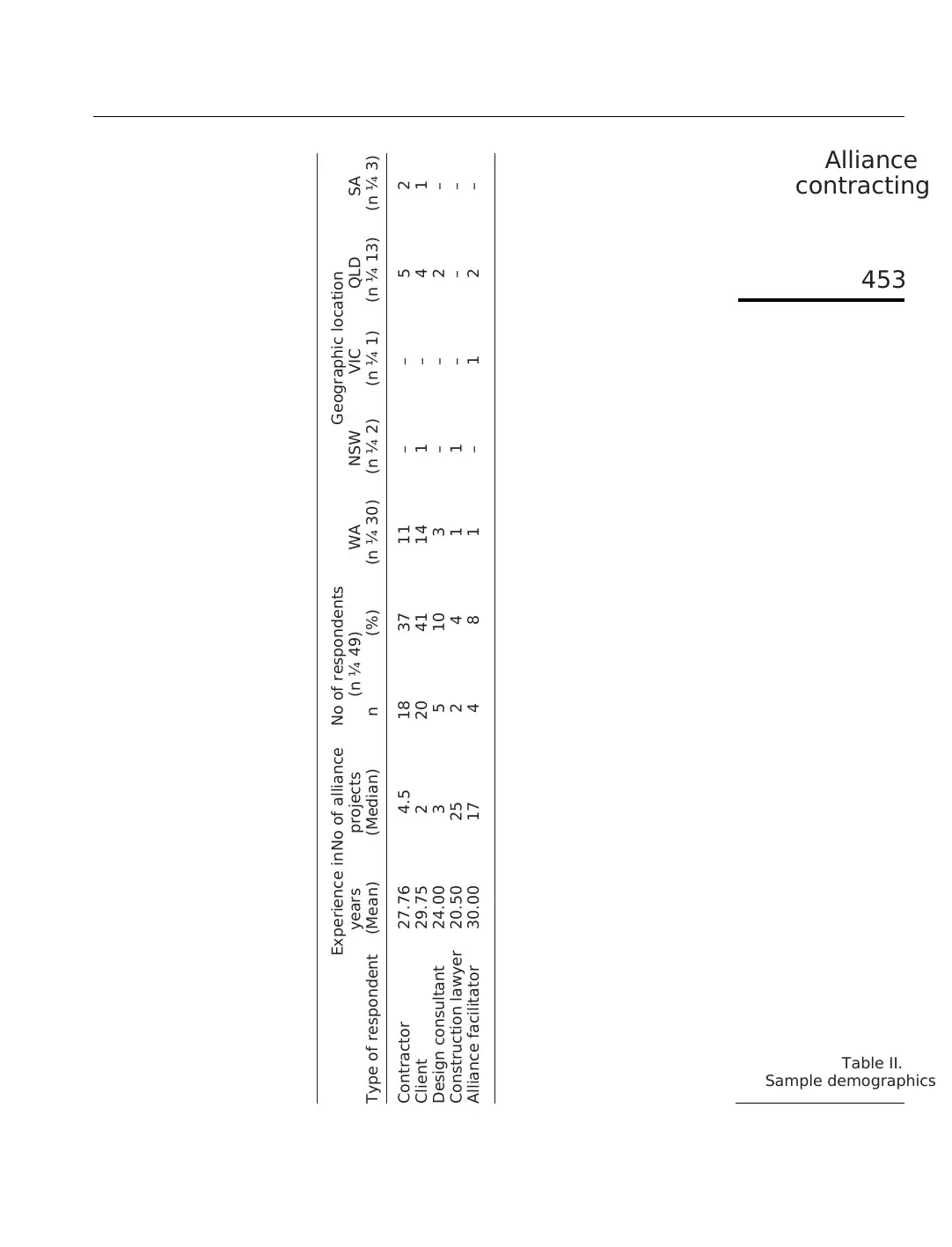
No of respondents Geographic locationExperience in
years
No of alliance
projects (n ¼ 49) WA NSW VIC QLD SA
Type of respondent (Mean) (Median) n (%) (n ¼ 30) (n ¼ 2) (n ¼ 1) (n ¼ 13) (n ¼ 3)
Contractor 27.76 4.5 18 37 11 – – 5 2
Client 29.75 2 20 41 14 1 – 4 1
Design consultant 24.00 3 5 10 3 – – 2 –
Construction lawyer 20.50 25 2 4 1 1 – – –
Alliance facilitator 30.00 17 4 8 1 – 1 2 –
Table II.
Sample demographics
Alliance
contracting
453
years
No of alliance
projects (n ¼ 49) WA NSW VIC QLD SA
Type of respondent (Mean) (Median) n (%) (n ¼ 30) (n ¼ 2) (n ¼ 1) (n ¼ 13) (n ¼ 3)
Contractor 27.76 4.5 18 37 11 – – 5 2
Client 29.75 2 20 41 14 1 – 4 1
Design consultant 24.00 3 5 10 3 – – 2 –
Construction lawyer 20.50 25 2 4 1 1 – – –
Alliance facilitator 30.00 17 4 8 1 – 1 2 –
Table II.
Sample demographics
Alliance
contracting
453
Paraphrase This Document
Need a fresh take? Get an instant paraphrase of this document with our AI Paraphraser
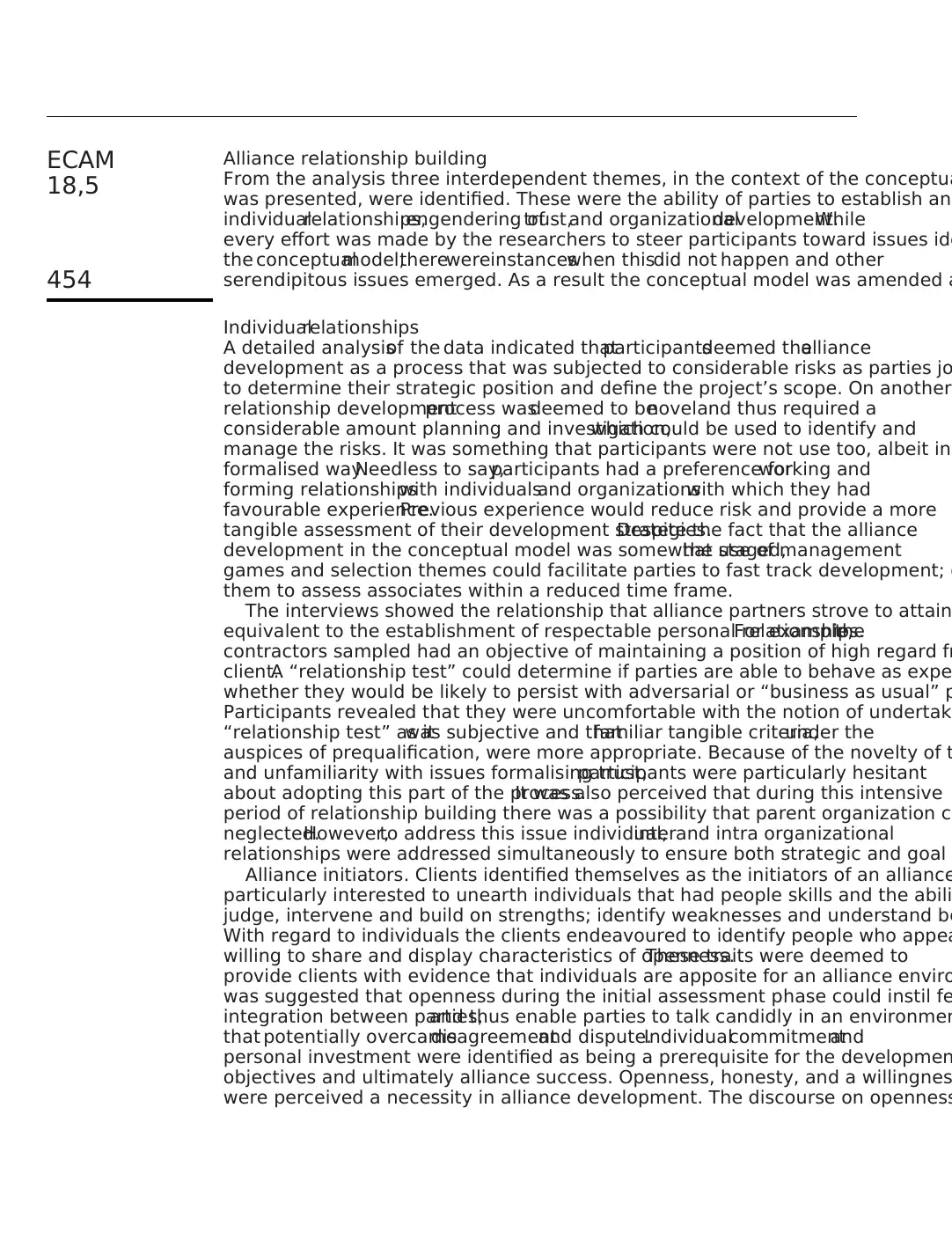
Alliance relationship building
From the analysis three interdependent themes, in the context of the conceptua
was presented, were identified. These were the ability of parties to establish and
individualrelationships,engendering oftrust,and organizationaldevelopment.While
every effort was made by the researchers to steer participants toward issues ide
the conceptualmodel,therewereinstanceswhen thisdid not happen and other
serendipitous issues emerged. As a result the conceptual model was amended a
Individualrelationships
A detailed analysisof the data indicated thatparticipantsdeemed thealliance
development as a process that was subjected to considerable risks as parties jo
to determine their strategic position and define the project’s scope. On another
relationship developmentprocess wasdeemed to benoveland thus required a
considerable amount planning and investigation,which could be used to identify and
manage the risks. It was something that participants were not use too, albeit in
formalised way.Needless to say,participants had a preference forworking and
forming relationshipswith individualsand organizationswith which they had
favourable experience.Previous experience would reduce risk and provide a more
tangible assessment of their development strategies.Despite the fact that the alliance
development in the conceptual model was somewhat staged,the use of management
games and selection themes could facilitate parties to fast track development; e
them to assess associates within a reduced time frame.
The interviews showed the relationship that alliance partners strove to attain
equivalent to the establishment of respectable personal relationships.For example,the
contractors sampled had an objective of maintaining a position of high regard fr
client.A “relationship test” could determine if parties are able to behave as expe
whether they would be likely to persist with adversarial or “business as usual” p
Participants revealed that they were uncomfortable with the notion of undertak
“relationship test” as itwas subjective and thatfamiliar tangible criteria,under the
auspices of prequalification, were more appropriate. Because of the novelty of t
and unfamiliarity with issues formalising trust,participants were particularly hesitant
about adopting this part of the process.It was also perceived that during this intensive
period of relationship building there was a possibility that parent organization c
neglected.However,to address this issue individual,interand intra organizational
relationships were addressed simultaneously to ensure both strategic and goal
Alliance initiators. Clients identified themselves as the initiators of an alliance
particularly interested to unearth individuals that had people skills and the abili
judge, intervene and build on strengths; identify weaknesses and understand be
With regard to individuals the clients endeavoured to identify people who appea
willing to share and display characteristics of openness.These traits were deemed to
provide clients with evidence that individuals are apposite for an alliance enviro
was suggested that openness during the initial assessment phase could instil fe
integration between parties,and thus enable parties to talk candidly in an environmen
that potentially overcamedisagreementand dispute.Individualcommitmentand
personal investment were identified as being a prerequisite for the developmen
objectives and ultimately alliance success. Openness, honesty, and a willingnes
were perceived a necessity in alliance development. The discourse on openness
ECAM
18,5
454
From the analysis three interdependent themes, in the context of the conceptua
was presented, were identified. These were the ability of parties to establish and
individualrelationships,engendering oftrust,and organizationaldevelopment.While
every effort was made by the researchers to steer participants toward issues ide
the conceptualmodel,therewereinstanceswhen thisdid not happen and other
serendipitous issues emerged. As a result the conceptual model was amended a
Individualrelationships
A detailed analysisof the data indicated thatparticipantsdeemed thealliance
development as a process that was subjected to considerable risks as parties jo
to determine their strategic position and define the project’s scope. On another
relationship developmentprocess wasdeemed to benoveland thus required a
considerable amount planning and investigation,which could be used to identify and
manage the risks. It was something that participants were not use too, albeit in
formalised way.Needless to say,participants had a preference forworking and
forming relationshipswith individualsand organizationswith which they had
favourable experience.Previous experience would reduce risk and provide a more
tangible assessment of their development strategies.Despite the fact that the alliance
development in the conceptual model was somewhat staged,the use of management
games and selection themes could facilitate parties to fast track development; e
them to assess associates within a reduced time frame.
The interviews showed the relationship that alliance partners strove to attain
equivalent to the establishment of respectable personal relationships.For example,the
contractors sampled had an objective of maintaining a position of high regard fr
client.A “relationship test” could determine if parties are able to behave as expe
whether they would be likely to persist with adversarial or “business as usual” p
Participants revealed that they were uncomfortable with the notion of undertak
“relationship test” as itwas subjective and thatfamiliar tangible criteria,under the
auspices of prequalification, were more appropriate. Because of the novelty of t
and unfamiliarity with issues formalising trust,participants were particularly hesitant
about adopting this part of the process.It was also perceived that during this intensive
period of relationship building there was a possibility that parent organization c
neglected.However,to address this issue individual,interand intra organizational
relationships were addressed simultaneously to ensure both strategic and goal
Alliance initiators. Clients identified themselves as the initiators of an alliance
particularly interested to unearth individuals that had people skills and the abili
judge, intervene and build on strengths; identify weaknesses and understand be
With regard to individuals the clients endeavoured to identify people who appea
willing to share and display characteristics of openness.These traits were deemed to
provide clients with evidence that individuals are apposite for an alliance enviro
was suggested that openness during the initial assessment phase could instil fe
integration between parties,and thus enable parties to talk candidly in an environmen
that potentially overcamedisagreementand dispute.Individualcommitmentand
personal investment were identified as being a prerequisite for the developmen
objectives and ultimately alliance success. Openness, honesty, and a willingnes
were perceived a necessity in alliance development. The discourse on openness
ECAM
18,5
454
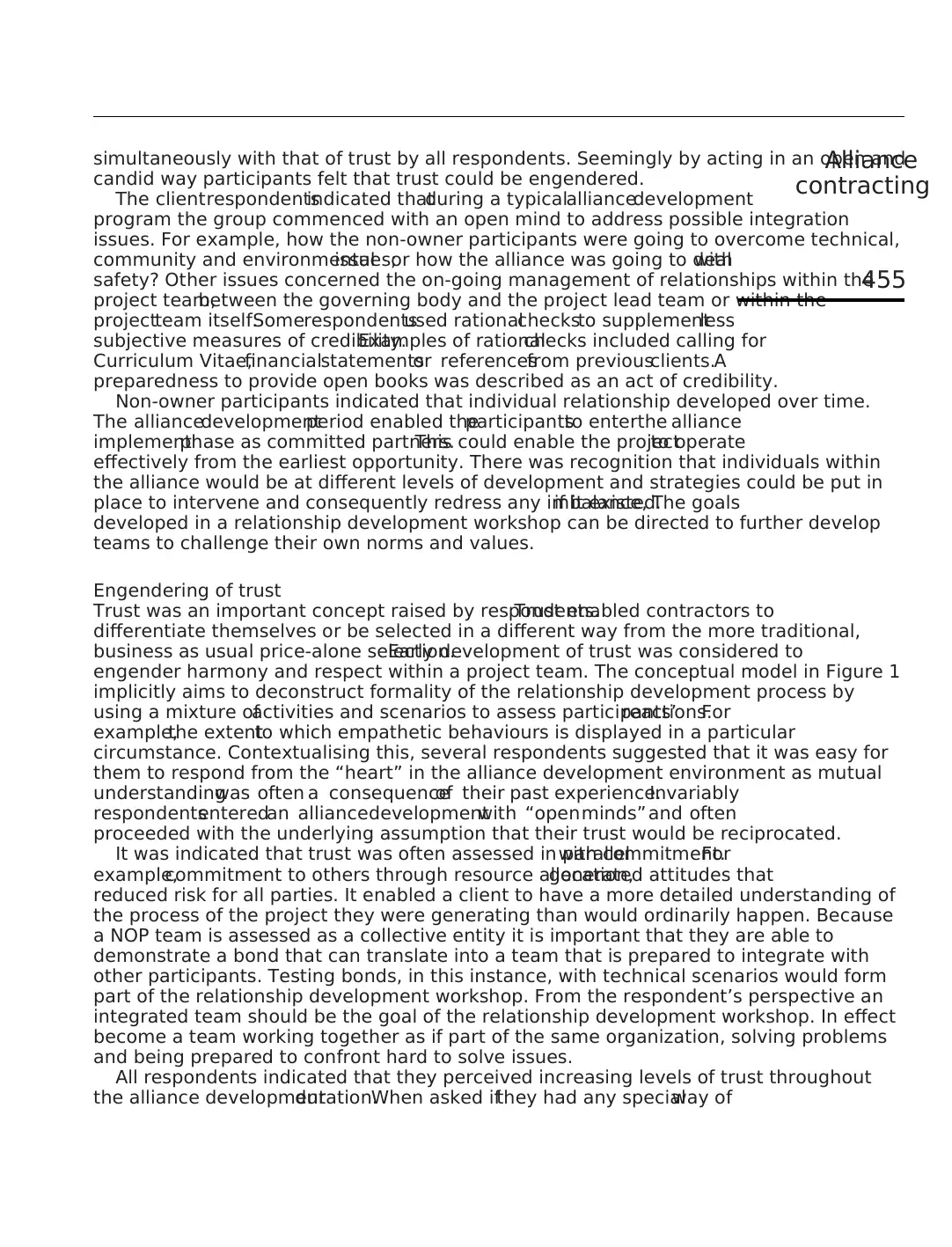
simultaneously with that of trust by all respondents. Seemingly by acting in an open and
candid way participants felt that trust could be engendered.
The clientrespondentsindicated thatduring a typicalalliancedevelopment
program the group commenced with an open mind to address possible integration
issues. For example, how the non-owner participants were going to overcome technical,
community and environmentalissues;or how the alliance was going to dealwith
safety? Other issues concerned the on-going management of relationships within the
project team,between the governing body and the project lead team or within the
projectteam itself.Somerespondentsused rationalchecksto supplementless
subjective measures of credibility.Examples of rationalchecks included calling for
Curriculum Vitae,financialstatementsor referencesfrom previousclients.A
preparedness to provide open books was described as an act of credibility.
Non-owner participants indicated that individual relationship developed over time.
The alliancedevelopmentperiod enabled theparticipantsto enterthe alliance
implementphase as committed partners.This could enable the projectto operate
effectively from the earliest opportunity. There was recognition that individuals within
the alliance would be at different levels of development and strategies could be put in
place to intervene and consequently redress any imbalance,if it existed.The goals
developed in a relationship development workshop can be directed to further develop
teams to challenge their own norms and values.
Engendering of trust
Trust was an important concept raised by respondents.Trust enabled contractors to
differentiate themselves or be selected in a different way from the more traditional,
business as usual price-alone selection.Early development of trust was considered to
engender harmony and respect within a project team. The conceptual model in Figure 1
implicitly aims to deconstruct formality of the relationship development process by
using a mixture ofactivities and scenarios to assess participants’reactions.For
example,the extentto which empathetic behaviours is displayed in a particular
circumstance. Contextualising this, several respondents suggested that it was easy for
them to respond from the “heart” in the alliance development environment as mutual
understandingwas often a consequenceof their past experience.Invariably
respondentsenteredan alliancedevelopmentwith “openminds” and often
proceeded with the underlying assumption that their trust would be reciprocated.
It was indicated that trust was often assessed in parallelwith commitment.For
example,commitment to others through resource allocation,generated attitudes that
reduced risk for all parties. It enabled a client to have a more detailed understanding of
the process of the project they were generating than would ordinarily happen. Because
a NOP team is assessed as a collective entity it is important that they are able to
demonstrate a bond that can translate into a team that is prepared to integrate with
other participants. Testing bonds, in this instance, with technical scenarios would form
part of the relationship development workshop. From the respondent’s perspective an
integrated team should be the goal of the relationship development workshop. In effect
become a team working together as if part of the same organization, solving problems
and being prepared to confront hard to solve issues.
All respondents indicated that they perceived increasing levels of trust throughout
the alliance developmentduration.When asked ifthey had any specialway of
Alliance
contracting
455
candid way participants felt that trust could be engendered.
The clientrespondentsindicated thatduring a typicalalliancedevelopment
program the group commenced with an open mind to address possible integration
issues. For example, how the non-owner participants were going to overcome technical,
community and environmentalissues;or how the alliance was going to dealwith
safety? Other issues concerned the on-going management of relationships within the
project team,between the governing body and the project lead team or within the
projectteam itself.Somerespondentsused rationalchecksto supplementless
subjective measures of credibility.Examples of rationalchecks included calling for
Curriculum Vitae,financialstatementsor referencesfrom previousclients.A
preparedness to provide open books was described as an act of credibility.
Non-owner participants indicated that individual relationship developed over time.
The alliancedevelopmentperiod enabled theparticipantsto enterthe alliance
implementphase as committed partners.This could enable the projectto operate
effectively from the earliest opportunity. There was recognition that individuals within
the alliance would be at different levels of development and strategies could be put in
place to intervene and consequently redress any imbalance,if it existed.The goals
developed in a relationship development workshop can be directed to further develop
teams to challenge their own norms and values.
Engendering of trust
Trust was an important concept raised by respondents.Trust enabled contractors to
differentiate themselves or be selected in a different way from the more traditional,
business as usual price-alone selection.Early development of trust was considered to
engender harmony and respect within a project team. The conceptual model in Figure 1
implicitly aims to deconstruct formality of the relationship development process by
using a mixture ofactivities and scenarios to assess participants’reactions.For
example,the extentto which empathetic behaviours is displayed in a particular
circumstance. Contextualising this, several respondents suggested that it was easy for
them to respond from the “heart” in the alliance development environment as mutual
understandingwas often a consequenceof their past experience.Invariably
respondentsenteredan alliancedevelopmentwith “openminds” and often
proceeded with the underlying assumption that their trust would be reciprocated.
It was indicated that trust was often assessed in parallelwith commitment.For
example,commitment to others through resource allocation,generated attitudes that
reduced risk for all parties. It enabled a client to have a more detailed understanding of
the process of the project they were generating than would ordinarily happen. Because
a NOP team is assessed as a collective entity it is important that they are able to
demonstrate a bond that can translate into a team that is prepared to integrate with
other participants. Testing bonds, in this instance, with technical scenarios would form
part of the relationship development workshop. From the respondent’s perspective an
integrated team should be the goal of the relationship development workshop. In effect
become a team working together as if part of the same organization, solving problems
and being prepared to confront hard to solve issues.
All respondents indicated that they perceived increasing levels of trust throughout
the alliance developmentduration.When asked ifthey had any specialway of
Alliance
contracting
455
⊘ This is a preview!⊘
Do you want full access?
Subscribe today to unlock all pages.

Trusted by 1+ million students worldwide
1 out of 18
Your All-in-One AI-Powered Toolkit for Academic Success.
+13062052269
info@desklib.com
Available 24*7 on WhatsApp / Email
![[object Object]](/_next/static/media/star-bottom.7253800d.svg)
Unlock your academic potential
Copyright © 2020–2025 A2Z Services. All Rights Reserved. Developed and managed by ZUCOL.
